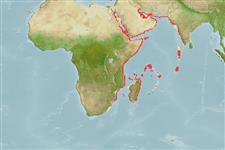Environment: milieu / climate zone / depth range / distribution range
Ecologia
marino associati a barriera corallina; distribuzione batimetrica 5 - 20 m (Ref. 559). Subtropical; 30°N - 26°S, 34°E - 60°E
Western Indian Ocean: Red Sea and Persian Gulf south to Mozambique, Aldabra and Madagascar.
Size / Peso / Age
Maturity: Lm ? range ? - ? cm
Max length : 17.0 cm TL maschio/sesso non determinato; (Ref. 559); peso massimo pubblicato: 33.13 g (Ref. 124708)
Spine dorsali (totale) : 8; Raggi dorsali molli (totale) : 8 - 9; Spine anali: 2; Raggi anali molli: 6 - 8. Eyes slightly larger than snout. Preopercular edge serrated, preopercular ridge smooth, weakly denticulate at angle. Brownish or silver grey. 3 darker vertical bands on each side, the first including a black ocellus with yellow or white ring, last band near the base of caudal fin.
Inhabits coastal reefs, in shallow silty areas, and in mangroves (Ref. 9710).
Life cycle and mating behavior
Maturità | Riproduzione | Deposizione | Uova | Fecundity | Larve
Mouthbrooders (Ref. 240). Distinct pairing during courtship and spawning (Ref. 205).
Tortonese, E., 1986. Apogonidae. p. 803-809. In P.J.P. Whitehead, M.-L. Bauchot, J.-C. Hureau, J. Nielsen and E. Tortonese (eds.) Fishes of the north-eastern Atlantic and the Mediterranean. UNESCO, Paris. vol. 2. (Ref. 4738)
IUCN Red List Status (Ref. 130435: Version 2024-1)
Threat to humans
Harmless
Human uses
Strumenti
Special reports
Download XML
Fonti Internet
Estimates based on models
Preferred temperature (Ref.
123201): 25 - 29.1, mean 27.5 °C (based on 721 cells).
Phylogenetic diversity index (Ref.
82804): PD
50 = 0.5000 [Uniqueness, from 0.5 = low to 2.0 = high].
Bayesian length-weight: a=0.01349 (0.00754 - 0.02415), b=3.00 (2.84 - 3.16), in cm total length, based on LWR estimates for this species & (Sub)family-body (Ref.
93245).
Trophic level (Ref.
69278): 3.7 ±0.50 se; based on food items.
Resilienza (Ref.
120179): Alto, tempo minimo di raddoppiamento della popolazione meno di 15 mesi (Preliminary K or Fecundity.).
Fishing Vulnerability (Ref.
59153): Low vulnerability (10 of 100).
